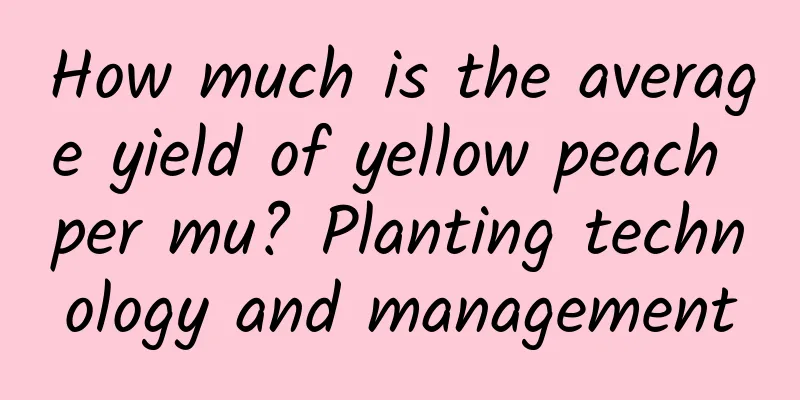How much is the average yield of yellow peach per mu? Planting technology and management

Yellow peach yield per muThe average yield of yellow peaches is about 5,000 catties per mu . If the Golden Crown yellow peaches are densely planted and well managed, the yield per mu can reach 2,000 to 4,000 catties in the second year and 6,000 to 8,000 catties in the third year. Yellow peach planting prospects1. Planting cost Only about 50 yellow peach trees can be planted per acre, and the cost includes the cost of saplings, land rental, fertilizers, pesticides, equipment, labor, etc. The total planting cost per acre is about 5,000 to 8,000 yuan. If the current purchase price is 4 yuan per catty, the total profit per acre is about 20,000 yuan. According to the wholesale price, the profit can reach hundreds of thousands of yuan, and after deducting the cost, it can still earn 100,000 yuan. The profit of planting yellow peaches is still considerable. 2. Planting prospects Yellow peaches are easy to grow and manage, and are suitable for large-scale farms. As the processing industry develops, its products are increasing, and the market demand for yellow peaches is increasing. In general, it has been rising. In addition, yellow peaches in the production area are bagged, which significantly improves the quality of yellow peaches on the market. Whenever yellow peaches are on the market, the market demand will increase. If you want to grow yellow peaches with high efficiency, you must use scientific cultivation and management techniques to improve the quality of yellow peaches. How to grow yellow peaches to achieve high yield1. Planting of seedlings: Choose to do it in late winter or early spring or in winter, preferably no later than the end of February. This will significantly improve the survival rate. Before planting, choose relatively high-quality seedlings, bury them in the soil three times, tamp them down twice, and lift them up once. 2. Fertilizer management: After the fruit is harvested in September or October, apply decomposed organic fertilizer in combination with tillage and soil improvement, and mix in diammonium dihydrogen phosphate and potassium sulfate. Generally, 3,000 to 4,000 kilograms of organic fertilizer are applied per mu, mainly in ditches, to avoid direct contact between plant roots and fertilizer to avoid burns. 3. Water management: Do not water too much during the flowering period, as this will cause the flowers and fruits to fall. However, during the growth period of the fruit, if there is drought and high temperature, the ground should be watered, and the leaves should be sprayed in the morning or evening. Peach trees are afraid of waterlogging, so drainage preparations should be made. 4. Field management: The most important thing in field management is fertilization. During the young tree period, fertilization should be applied in small amounts and frequently, with nitrogen fertilizer as the main ingredient to promote the growth of branches and leaves. |
<<: Is konjac a carbohydrate or a vegetable?
>>: Can Bodhi trees be planted in the north?
Recommend
How long does it take for the snow to adapt to the basin?
Light snow acclimatization time Danxue will accli...
What to do with daisies after they bloom
1. Block light Because daisies bloom in late spri...
How to prune Brazilian wood
Brazilian wood pruning tools Pruning Brazilian wo...
Will the plant die after taking root and blooming?
1. Will the plant die after flowering? It is a ve...
How to prepare soil for Desert Rose? What soil is best for planting?
1. How to prepare soil 1. Desert rose cannot tole...
The reason why the leaves of coleus turn black
1. Infection Cause: The leaves of coleus turn bla...
How to make grafted Christmas cactus bloom in the same year
1. Time selection for grafting Weather has a grea...
Making and maintaining weeping begonia bonsai
Making of Weeping Begonia Bonsai Prepare the soil...
How to repot cyclamen and what to pay attention to when repotting
1. Repotting method 1. Cut off water and remove f...
How to prune Milan and when is the best time to prune Milan
1. Topping Milan needs to be topped during the se...
How to distinguish between Yachiyo and Otome Kokoro
1. Look at the pole Looking at the pole is the ea...
What flowers are suitable for growing in Hulunbuir? What are the city flowers and trees?
1. Climate characteristics of Hulunbuir Hulunbuir...
What to do if the bulb of Gloxinia rots
Gloxinia rot ball Gloxinia is easy to rot. When g...
Planting methods and precautions for wintersweet
1. Prepare the soil Before planting wintersweet, ...
Cultivation methods and precautions of red silk
1. Maintenance methods 1. Soil: Loose, porous soi...









